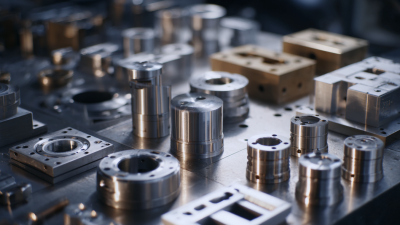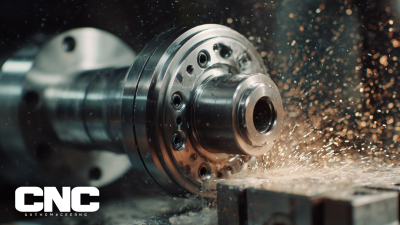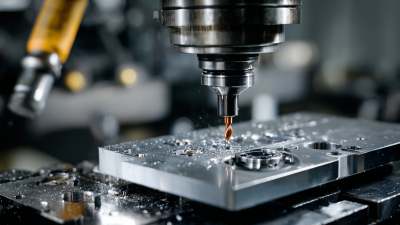
- sales@bjbod.com
- Mon - Sat at 7:00AM to 9:00PM

In the ever-evolving landscape of manufacturing, the selection of materials for custom machined parts is crucial for achieving optimal performance and cost efficiency. According to recent industry reports, the global custom machined parts market is projected to reach $10.53 billion by 2026, reflecting a compound annual growth rate (CAGR) of 4.5%. This growth underscores the importance of choosing the right materials, as they directly influence the durability, weight, and overall functionality of the finished product. Engineers and designers must consider factors such as material properties, compatibility with machining processes, and application-specific requirements to ensure the success of their projects. By understanding these critical elements, stakeholders can make informed decisions that not only enhance product quality but also boost competitiveness in the marketplace.

When selecting the best materials for custom machined parts, understanding the application requirements is crucial. The specific conditions in which the parts will operate dictate not only the material choice but also the design features. For instance, if a part will experience high temperatures or corrosive environments, materials like stainless steel or specialized alloys may be necessary. Conversely, in applications where weight reduction is paramount, engineers might consider lightweight materials such as aluminum or composites.
Additionally, factors such as mechanical strength, fatigue resistance, and thermal conductivity play significant roles in material selection. It's essential to assess the stresses the part will endure and how often it will be in use. Custom machined parts that will undergo heavy loads or constant motion will demand robust materials that can withstand wear. By thoroughly evaluating these application-specific criteria, engineers can make informed decisions that enhance the performance and longevity of custom machined components, ultimately leading to a successful project outcome.
 When selecting materials for custom machined parts, evaluating material properties is crucial for ensuring optimal performance in your project. Factors such as tensile strength, hardness, and corrosion resistance play a significant role in determining the most suitable material. According to the Material Data Repository, materials like aluminum alloys or stainless steel often provide a perfect balance of strength and weight, making them ideal for applications where both durability and performance are required.
When selecting materials for custom machined parts, evaluating material properties is crucial for ensuring optimal performance in your project. Factors such as tensile strength, hardness, and corrosion resistance play a significant role in determining the most suitable material. According to the Material Data Repository, materials like aluminum alloys or stainless steel often provide a perfect balance of strength and weight, making them ideal for applications where both durability and performance are required.
Tips:
When selecting materials for custom machined parts, understanding the cost and availability of machining materials is crucial. According to a report by Grand View Research, the global machine parts manufacturing market is projected to reach USD 2.86 trillion by 2025, highlighting the growing demand for quality materials. Popular options such as aluminum and stainless steel are often favored due to their balance of cost-effectiveness and versatility. For instance, aluminum alloy 6061 is typically priced between $2.50 to $3.00 per pound, making it an affordable choice for various applications that require excellent machinability and corrosion resistance.

On the other hand, high-performance materials like titanium and engineering plastics, while offering superior properties, tend to have higher costs and more limited availability. Market research indicates that titanium can range from $15 to $20 per pound, which may impact project budgets significantly. Additionally, sourcing specialized materials can lead to extended lead times, potentially affecting project timelines. Evaluating the trade-offs between cost, availability, and the specific requirements of your project is essential to selecting the most fitting materials for your custom machined parts.
In the realm of custom machined parts, assessing compatibility with manufacturing processes is crucial for project success. According to a report by the International Journal of Advanced Manufacturing Technology, almost 70% of production issues stem from material selection that does not align with the chosen manufacturing method. For instance, materials that are too hard, like certain alloys, can be challenging to machine with standard techniques, leading to increased tool wear and production costs.
Moreover, understanding the thermal and physical properties of materials is essential to ensure compatibility with processes such as CNC machining or additive manufacturing. A study by the Society of Manufacturing Engineers highlights that materials should have a melting point that corresponds with the manufacturing process to prevent distortion or loss of integrity during fabrication. For example, thermoplastic materials used in 3D printing need to exhibit properties such as low melting temperatures and good flow characteristics to ensure proper extrusion and layer bonding. By carefully evaluating the interplay between material properties and manufacturing techniques, engineers can optimize performance and cost-effectiveness in their projects.
In today's market, sustainability considerations in material selection have become more critical than ever. With 79% of consumers considering sustainability during holiday shopping and 76% willing to pay more for eco-friendly products, businesses face increasing pressure to choose materials that align with these values. This shift is particularly relevant in custom machining applications, where the choice of materials not only impacts functionality but also ecological footprint.
For instance, biodegradable plastics and alternative materials such as rice bran wax stand out for their reduced environmental impact compared to traditional options like lignite wax. Companies can leverage the growing consumer demand for sustainability by adopting these innovative materials. Furthermore, the push for greener logistics—encompassing strategies such as carbon-neutral shipping and eco-friendly packaging—integrates seamlessly with sustainable material selection, enhancing overall project sustainability. As businesses navigate the complexities of modern supply chains, a focus on environmentally responsible materials can lead to improved brand perception and customer loyalty, driving success in an increasingly eco-conscious economy.
| Material Type | Mechanical Properties | Sustainability Rating | Cost ($/kg) | Common Applications |
|---|---|---|---|---|
| Aluminum 6061 | High strength, lightweight | Good | 3.00 | Aerospace, automotive |
| Stainless Steel 304 | Corrosion resistant, durable | Fair | 4.50 | Medical instruments, food processing |
| PLA (Polylactic Acid) | Moderate strength, biodegradable | Excellent | 1.50 | 3D printing, prototyping |
| Carbon Steel | High strength, tough | Poor | 2.00 | Construction, automotive |
| Titanium Alloy | High strength-to-weight ratio | Good | 20.00 | Aerospace, medical implants |





